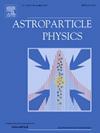超越局部宇宙:标量场与非相对论性中微子耦合对体流的影响
IF 4.2
3区 物理与天体物理
Q1 ASTRONOMY & ASTROPHYSICS
引用次数: 0
摘要
这项研究探索了中微子在宇宙膨胀历史中的作用,追踪了它们从宇宙早期的相对论阶段到后来的非相对论大质量粒子的转变。在中微子与标量场耦合的框架内,我们考察了宇宙从辐射主导到暗能量主导的演化。通过分析组合数据集(Pantheon+、宇宙微波背景、重子声学振荡、宇宙天文钟和CMB透镜),我们将中微子的总质量限制在∑mν<;0.105eV (95% CL)。过渡红移znr的范围从76到205,标志着物质统治的开始。耦合参数被约束为α=5.64±1.1,这与不断增长的中微子精质一致,增强了中微子的作用,尽管它们的质量很小。后期演化分析,比较有和没有中微子耦合的情况,揭示了非相对论性中微子对宇宙各向异性的贡献。在低红移(0.001<z<0.1)时,体流方向与CMB偶极子一致,而在高红移时,它与暗能量偶极子相关。中微子密度与红移比的演化表明,中微子密度的减小减弱了引力的影响,导致体速度在0.1<z<;1内增加,在1<;z<;1.4内下降。这些发现强调了非相对论中微子在塑造宇宙各向异性和暗能量动力学中的作用,为宇宙的大规模演化提供了新的视角。本文章由计算机程序翻译,如有差异,请以英文原文为准。
Beyond the local Universe: Impacts of scalar field coupled to non-relativistic neutrinos on bulk flow
This study explores the role of neutrinos in the Universe’s expansion history, tracing their transition from a relativistic phase in the early Universe to non-relativistic massive particles at later epochs. Within the framework of neutrino coupling with a scalar field, we examine cosmic evolution from radiation domination to dark energy dominance. By analyzing combined datasets (Pantheon+, Cosmic Microwave Background, Baryon Acoustic Oscillations, Cosmic Chronometers, and CMB lensing), we constrain the total neutrino mass to (95% CL). The transition redshifts range from 76 to 205, marking the onset of matter domination. The coupling parameter is constrained to , consistent with growing neutrino quintessence, reinforcing the role of neutrinos despite their small mass. Late-time evolution analyses, comparing scenarios with and without neutrino coupling, reveal that non-relativistic neutrinos contribute to cosmic anisotropy. At low redshifts (), the bulk flow direction aligns with the CMB dipole, while at higher redshifts, it correlates with the dark energy dipole. The evolution of neutrino density-to-redshift ratios suggests that a decreasing neutrino density weakens gravitational influence, leading to an increase in bulk velocity within and a decline within . These findings highlight the role of non-relativistic neutrinos in shaping cosmic anisotropy and dark energy dynamics, offering new perspectives on the Universe’s large-scale evolution.
求助全文
通过发布文献求助,成功后即可免费获取论文全文。
去求助
来源期刊

Astroparticle Physics
地学天文-天文与天体物理
CiteScore
8.00
自引率
2.90%
发文量
41
审稿时长
79 days
期刊介绍:
Astroparticle Physics publishes experimental and theoretical research papers in the interacting fields of Cosmic Ray Physics, Astronomy and Astrophysics, Cosmology and Particle Physics focusing on new developments in the following areas: High-energy cosmic-ray physics and astrophysics; Particle cosmology; Particle astrophysics; Related astrophysics: supernova, AGN, cosmic abundances, dark matter etc.; Gravitational waves; High-energy, VHE and UHE gamma-ray astronomy; High- and low-energy neutrino astronomy; Instrumentation and detector developments related to the above-mentioned fields.
 求助内容:
求助内容: 应助结果提醒方式:
应助结果提醒方式:


